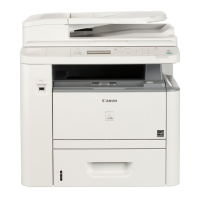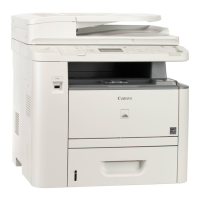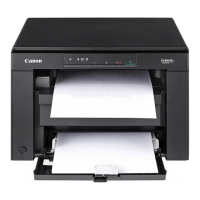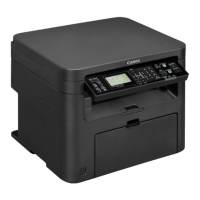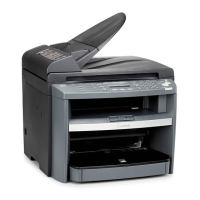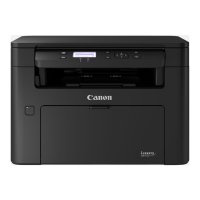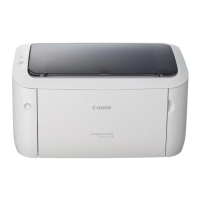Do you have a question about the Canon imageCLASS D570 and is the answer not in the manual?
Precautions and steps for safely installing the machine in an appropriate location.
Guidelines for connecting and using the power supply to prevent hazards.
Precautions to take when handling the machine to prevent injury or damage.
Procedures for regular cleaning and inspection to ensure proper machine operation.
Safety and handling information for consumables, including toner cartridges.
Description of the machine's exterior and interior parts and their functions.
Instructions on how to toggle the display and select items on the operation panel.
Guidance on how to place documents on the platen glass for copying or scanning.
Procedure for loading paper into the paper drawer and manual feed slot.
How to set the machine to quiet mode to reduce operation sound.
Instructions on how to set the machine to sleep mode to save power.
Step-by-step guide for performing basic copying operations on the machine.
Procedure for canceling copying operations immediately or after checking status.
Overview of various copy settings to suit user needs, such as paper saving.
How to enlarge or reduce copies using preset or custom copy ratios.
Selecting the optical image quality based on document type for optimal results.
How to adjust the density of copies to make text or images lighter or darker.
How to adjust the sharpness of copied images to sharpen text or improve photo appearance.
Instructions on how to copy two pages of a document on both sides of the paper.
How to copy multiple pages onto a single sheet to save paper.
Utilizing the Paper Save Copy key to combine functions for paper saving.
How to copy the front and back sides of an ID card onto a single page.
Setting the Collate option to arrange copies in sequential page order.
How to change factory default settings for frequently used copy operations.
Instructions on printing documents from a computer using the printer driver.
Printing photos and web pages from mobile devices like smartphones and tablets.
Prerequisites and setup steps required before using the machine as a scanner.
How to scan and save documents to a computer using the operation panel.
Scanning documents placed on the machine from a computer using software.
Scanning documents directly into applications like word processors or image editors.
How to configure advanced scan settings using the ScanGear MF driver.
Methods for connecting the machine to a mobile device via Wi-Fi or direct connection.
Steps to establish a wireless direct connection between a mobile device and the machine.
Using applications to perform printing, scanning, and other operations from a mobile device.
Printing or scanning wirelessly from Apple devices using AirPrint without drivers.
Printing documents from applications compatible with Google Cloud Print via the Internet.
Operating the machine remotely via a Web browser on a mobile device for status checks and settings.
Registering identification information and enabling/disabling AirPrint function via Remote UI.
Details on printing and scanning capabilities available through AirPrint.
Solutions for common issues encountered when AirPrint cannot be used.
Verifying network and date/time settings required for Google Cloud Print setup.
Enabling or disabling the Google Cloud Print function of the machine.
Procedure to register the machine for printing from anywhere via Google Cloud Print.
Steps to access the Remote UI using a Web browser on a mobile device.
Setting up the machine to connect to a wired or wireless local area network (LAN).
Choosing between wired LAN or wireless LAN connection using the operation panel.
Procedure for connecting the machine to a computer via a router using a LAN cable.
Connecting the machine to a computer via radio waves using wireless routers or access points.
Easy setup using the WPS button on a wireless router for connection.
Configuring wireless connection by entering a PIN code from the machine to the router.
Searching for available wireless routers and selecting one for connection.
Manually entering SSID, network key, and security protocols for detailed wireless setup.
How to find and write down the SSID and network key required for wireless connection.
Configuring network IP addresses (IPv4 and IPv6) for the machine.
Assigning IPv4 addresses automatically or manually for network connectivity.
Configuring IPv6 addresses for the machine via the Remote UI.
Checking current IPv4, IPv6, and MAC address settings of the machine.
Configuring protocols, ports, and creating a print server for network printing.
Setting up LPD, RAW, and WSD protocols for printing documents from a networked computer.
Troubleshooting printing errors by checking or adding printer ports on the computer.
Reducing computer load by setting up a print server and installing drivers over the network.
Specifying network settings like Ethernet, DNS, and SNTP to suit your network environment.
Setting communication mode (duplex) and Ethernet type (10/100BASE-TX).
Adjusting the MTU size for optimal packet transmission based on network.
Setting a delay time to prevent communication disruption after network changes.
Configuring DNS, mDNS, or DHCP options for name resolution.
Adjusting the machine's system clock using a time server on the network.
Using SNMP to monitor and control network devices and machine status.
Implementing security measures like firewalls and port number changes to prevent unauthorized access.
Security measures to prevent unauthorized access from external networks.
Assigning a private IP address to restrict access to the local area network.
Using a firewall to block or permit communication based on IP addresses.
Information on enabling TLS for secure communication via Remote UI.
Setting PINs to protect stored information from unauthorized access and leakage.
Controlling machine access by assigning user privileges (System Manager/General User).
Setting a PIN exclusively for administrators to access advanced settings.
Setting a PIN for users to access the Remote UI.
Limiting or blocking communication to specific devices using IP or MAC address filters.
Configuring packet filters to restrict communication to devices with specified IP addresses.
Configuring packet filters to restrict communication to devices with specified MAC addresses.
Changing default port numbers for protocols to enhance security.
Configuring proxy server settings for managing traffic and enhancing security.
Limiting machine capabilities by disabling rarely used or potentially misused functions.
Disabling HTTP communication to block malicious intrusions via the unused HTTP port.
Disabling the Remote UI to reduce the risk of remote machine control by third parties.
Utilizing features like TLS and IEEE 802.1X authentication for enhanced security.
Encrypting communication between the machine and Web browser using TLS for secure access.
Setting up IEEE 802.1X for blocking unauthorized network access through user authentication.
Generating and registering key pairs and digital certificates for secure communication.
Generating key pairs required for encrypted communication via TLS or IEEE 802.1X.
Obtaining, storing, and registering key pairs and digital certificates from a CA.
Viewing detailed information and verifying the validity and signature of registered key pairs and certificates.
Step-by-step instructions for removing jammed paper or documents from the machine.
Information and solutions for various error messages displayed on the machine.
Troubleshooting common issues related to machine malfunction, installation, or settings.
Resolving issues related to machine installation, setup, or network connectivity.
Troubleshooting issues related to copy quality, paper feeding, or print failures.
Solutions for unsatisfactory print results, such as smudges, streaks, or faded output.
Identifying and resolving issues related to paper creasing or curling during printing.
Troubleshooting problems with paper skewing, misfeeds, or multiple sheets feeding together.
Information on contacting customer support when problems cannot be resolved.
Procedures for cleaning the exterior, platen glass, fixing assembly, and interior.
Instructions for wiping the machine's exterior and ventilation slots.
How to clean the platen glass and its cover to prevent smudges.
Procedure for cleaning the fixing unit to remove dirt causing black streaks.
Cleaning the machine's interior to prevent toner/paper dust accumulation.
Guidance on when and how to replace toner cartridges to maintain print quality.
Preparatory steps and cautions before removing and replacing a toner cartridge.
Detailed step-by-step instructions for replacing the toner cartridge.
Procedures for safely moving the machine to a new location, including disconnection and reconnection.
Checking the total number of pages used for printouts, copies, and data from computers.
Restoring various machine settings to their factory defaults.
Restoring specific settings or all settings to factory defaults.
Resetting the Eco Report Counter settings to factory defaults.
Deleting all registered data and settings, returning the machine to factory defaults.
Information related to third-party software used with the machine.
Overview of features grouped into categories like 'Going Green' and 'Improving Efficiency'.
Features that help save paper, toner, power, and expenses.
Simple operations and features that save time and increase productivity.
Features related to scanning documents and creating searchable PDFs.
Features like smartphone/tablet usage, Google Cloud Print, and wireless connectivity.
Technical specifications of the machine, including hardware and performance details.
Detailed specifications of the machine, including power, consumption, weight, and dimensions.
Technical details regarding the machine's wireless LAN standards, security, and connection methods.
Information on supported document sizes and paper capacity for scanning.
Diagrams indicating the scan area for copy and scan functions.
List of supported paper sizes, types, and capacity for drawers and manual feed.
Details on scan resolution, output resolution, copy ratio, speed, and capacity.
Specifications for the scanner, including maximum scan size, resolution, speed, and driver.
Specifications for the printer, including output tray capacity, speed, resolution, and toner.
Guide to estimated replacement times for consumables and recommended genuine parts.
List of included manuals, such as Getting Started and User's Guide.
Instructions on how to find topics and navigate within the User's Guide.
Explanation of the different screens and elements within the User's Guide interface.
Manual adjustments for display settings like contrast, colors, and units.
Includes basic Windows operations, disclaimers, and copyright information.
Guides on common Windows tasks like displaying folders and enabling network discovery.
A PDF manual showing the mapping of the machine's setting menu.
Information on ENERGY STAR, IPv6 Ready Logo, disclaimers, and trademarks.
Precautions and steps for safely installing the machine in an appropriate location.
Guidelines for connecting and using the power supply to prevent hazards.
Precautions to take when handling the machine to prevent injury or damage.
Procedures for regular cleaning and inspection to ensure proper machine operation.
Safety and handling information for consumables, including toner cartridges.
Description of the machine's exterior and interior parts and their functions.
Instructions on how to toggle the display and select items on the operation panel.
Guidance on how to place documents on the platen glass for copying or scanning.
Procedure for loading paper into the paper drawer and manual feed slot.
How to set the machine to quiet mode to reduce operation sound.
Instructions on how to set the machine to sleep mode to save power.
Step-by-step guide for performing basic copying operations on the machine.
Procedure for canceling copying operations immediately or after checking status.
Overview of various copy settings to suit user needs, such as paper saving.
How to enlarge or reduce copies using preset or custom copy ratios.
Selecting the optical image quality based on document type for optimal results.
How to adjust the density of copies to make text or images lighter or darker.
How to adjust the sharpness of copied images to sharpen text or improve photo appearance.
Instructions on how to copy two pages of a document on both sides of the paper.
How to copy multiple pages onto a single sheet to save paper.
Utilizing the Paper Save Copy key to combine functions for paper saving.
How to copy the front and back sides of an ID card onto a single page.
Setting the Collate option to arrange copies in sequential page order.
How to change factory default settings for frequently used copy operations.
Instructions on printing documents from a computer using the printer driver.
Printing photos and web pages from mobile devices like smartphones and tablets.
Prerequisites and setup steps required before using the machine as a scanner.
How to scan and save documents to a computer using the operation panel.
Scanning documents placed on the machine from a computer using software.
Scanning documents directly into applications like word processors or image editors.
How to configure advanced scan settings using the ScanGear MF driver.
Methods for connecting the machine to a mobile device via Wi-Fi or direct connection.
Steps to establish a wireless direct connection between a mobile device and the machine.
Using applications to perform printing, scanning, and other operations from a mobile device.
Printing or scanning wirelessly from Apple devices using AirPrint without drivers.
Printing documents from applications compatible with Google Cloud Print via the Internet.
Operating the machine remotely via a Web browser on a mobile device for status checks and settings.
Registering identification information and enabling/disabling AirPrint function via Remote UI.
Details on printing and scanning capabilities available through AirPrint.
Solutions for common issues encountered when AirPrint cannot be used.
Verifying network and date/time settings required for Google Cloud Print setup.
Enabling or disabling the Google Cloud Print function of the machine.
Procedure to register the machine for printing from anywhere via Google Cloud Print.
Steps to access the Remote UI using a Web browser on a mobile device.
Setting up the machine to connect to a wired or wireless local area network (LAN).
Choosing between wired LAN or wireless LAN connection using the operation panel.
Procedure for connecting the machine to a computer via a router using a LAN cable.
Connecting the machine to a computer via radio waves using wireless routers or access points.
Easy setup using the WPS button on a wireless router for connection.
Configuring wireless connection by entering a PIN code from the machine to the router.
Searching for available wireless routers and selecting one for connection.
Manually entering SSID, network key, and security protocols for detailed wireless setup.
How to find and write down the SSID and network key required for wireless connection.
Configuring network IP addresses (IPv4 and IPv6) for the machine.
Assigning IPv4 addresses automatically or manually for network connectivity.
Configuring IPv6 addresses for the machine via the Remote UI.
Checking current IPv4, IPv6, and MAC address settings of the machine.
Configuring protocols, ports, and creating a print server for network printing.
Setting up LPD, RAW, and WSD protocols for printing documents from a networked computer.
Troubleshooting printing errors by checking or adding printer ports on the computer.
Reducing computer load by setting up a print server and installing drivers over the network.
Specifying network settings like Ethernet, DNS, and SNTP to suit your network environment.
Setting communication mode (duplex) and Ethernet type (10/100BASE-TX).
Adjusting the MTU size for optimal packet transmission based on network.
Setting a delay time to prevent communication disruption after network changes.
Configuring DNS, mDNS, or DHCP options for name resolution.
Adjusting the machine's system clock using a time server on the network.
Using SNMP to monitor and control network devices and machine status.
Implementing security measures like firewalls and port number changes to prevent unauthorized access.
Security measures to prevent unauthorized access from external networks.
Assigning a private IP address to restrict access to the local area network.
Using a firewall to block or permit communication based on IP addresses.
Information on enabling TLS for secure communication via Remote UI.
Setting PINs to protect stored information from unauthorized access and leakage.
Controlling machine access by assigning user privileges (System Manager/General User).
Setting a PIN exclusively for administrators to access advanced settings.
Setting a PIN for users to access the Remote UI.
Limiting or blocking communication to specific devices using IP or MAC address filters.
Configuring packet filters to restrict communication to devices with specified IP addresses.
Configuring packet filters to restrict communication to devices with specified MAC addresses.
Changing default port numbers for protocols to enhance security.
Configuring proxy server settings for managing traffic and enhancing security.
Limiting machine capabilities by disabling rarely used or potentially misused functions.
Disabling HTTP communication to block malicious intrusions via the unused HTTP port.
Disabling the Remote UI to reduce the risk of remote machine control by third parties.
Utilizing features like TLS and IEEE 802.1X authentication for enhanced security.
Encrypting communication between the machine and Web browser using TLS for secure access.
Setting up IEEE 802.1X for blocking unauthorized network access through user authentication.
Generating and registering key pairs and digital certificates for secure communication.
Generating key pairs required for encrypted communication via TLS or IEEE 802.1X.
Obtaining, storing, and registering key pairs and digital certificates from a CA.
Viewing detailed information and verifying the validity and signature of registered key pairs and certificates.
Step-by-step instructions for removing jammed paper or documents from the machine.
Information and solutions for various error messages displayed on the machine.
Troubleshooting common issues related to machine malfunction, installation, or settings.
Resolving issues related to machine installation, setup, or network connectivity.
Troubleshooting issues related to copy quality, paper feeding, or print failures.
Solutions for unsatisfactory print results, such as smudges, streaks, or faded output.
Identifying and resolving issues related to paper creasing or curling during printing.
Troubleshooting problems with paper skewing, misfeeds, or multiple sheets feeding together.
Information on contacting customer support when problems cannot be resolved.
Procedures for cleaning the exterior, platen glass, fixing assembly, and interior.
Instructions for wiping the machine's exterior and ventilation slots.
How to clean the platen glass and its cover to prevent smudges.
Procedure for cleaning the fixing unit to remove dirt causing black streaks.
Cleaning the machine's interior to prevent toner/paper dust accumulation.
Guidance on when and how to replace toner cartridges to maintain print quality.
Preparatory steps and cautions before removing and replacing a toner cartridge.
Detailed step-by-step instructions for replacing the toner cartridge.
Procedures for safely moving the machine to a new location, including disconnection and reconnection.
Checking the total number of pages used for printouts, copies, and data from computers.
Restoring various machine settings to their factory defaults.
Restoring specific settings or all settings to factory defaults.
Resetting the Eco Report Counter settings to factory defaults.
Deleting all registered data and settings, returning the machine to factory defaults.
Information related to third-party software used with the machine.
Overview of features grouped into categories like 'Going Green' and 'Improving Efficiency'.
Features that help save paper, toner, power, and expenses.
Simple operations and features that save time and increase productivity.
Features related to scanning documents and creating searchable PDFs.
Features like smartphone/tablet usage, Google Cloud Print, and wireless connectivity.
Technical specifications of the machine, including hardware and performance details.
Detailed specifications of the machine, including power, consumption, weight, and dimensions.
Technical details regarding the machine's wireless LAN standards, security, and connection methods.
Information on supported document sizes and paper capacity for scanning.
Diagrams indicating the scan area for copy and scan functions.
List of supported paper sizes, types, and capacity for drawers and manual feed.
Details on scan resolution, output resolution, copy ratio, speed, and capacity.
Specifications for the scanner, including maximum scan size, resolution, speed, and driver.
Specifications for the printer, including output tray capacity, speed, resolution, and toner.
Guide to estimated replacement times for consumables and recommended genuine parts.
List of included manuals, such as Getting Started and User's Guide.
Instructions on how to find topics and navigate within the User's Guide.
Explanation of the different screens and elements within the User's Guide interface.
Manual adjustments for display settings like contrast, colors, and units.
Includes basic Windows operations, disclaimers, and copyright information.
Guides on common Windows tasks like displaying folders and enabling network discovery.
A PDF manual showing the mapping of the machine's setting menu.
Information on ENERGY STAR, IPv6 Ready Logo, disclaimers, and trademarks.
| Print Technology | Laser |
|---|---|
| Print Resolution | Up to 600 x 600 dpi |
| Duplex Printing | Yes |
| Monthly Duty Cycle | Up to 15, 000 pages |
| Display | 5-line LCD |
| Type | Monochrome Laser Printer |
| Scanner Type | Flatbed |
| Scan Resolution | Up to 600 x 600 dpi |
| Copier Speed | Up to 28 cpm (Black) |
| Copier Resolution | Up to 600 x 600 dpi |
| Automatic Document Feeder (ADF) | No |
| Printer Type | Monochrome Laser |
| Print Speed (Black) | Up to 28 ppm |
| Supported Operating Systems | Windows, Mac, Linux |
| Print Speed | Up to 28 ppm |
| Connectivity | USB 2.0 |
| Paper Handling | 1-sheet manual feed slot |
| Paper Sizes Supported | Letter, Legal, A4, A5, B5, Executive |
| Dimensions | 15.4 inches |
| Paper Capacity | 250 sheets |
